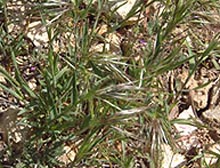
Plant List
Junipers- (juniperus) -Needles can be either scale-like or needle like, and these needle forms are typically mixed on the same branch. Fruits are leathery and look like berries; most often blue. Tree has distinctive, strong odor. Junipers are strange conifers; their fruits look like berries and their leaves may be either scale-like or needle-like. In fact, their fruits are round cones, but they're softer than most and they have a blue, red, or copper color. Junipers bear male and female flowers on separate trees, so only "female" trees have fruit. Juniper foliage may be scale-like, needle-like, or both, and it often has a distinctive odor that can be smelled from quite a distance.
Cheatgrass- (Bromus tectorum L.) – Annual, generally germinating in the fall and maturing the following spring, or germinating during the summer rainy season and maturing by early fall. Height varies extrodinarily, ranging from 5 or 6 inches to 2 feet. Light green when growin -- often purple at maturity and generally a light straw yellow after the plants have died. Overgrazing promotes the establishment of this invasive grass.

Bitter-root/ Sand Rose- (Lewisia rediviva) – A low herbaceous perennial arising from a stout, branching, fleshy taproot, which is gray-skinned with a white inner core which may turn pink on exposure to the air. The basal leaves are small, narrow and fleshy, borne in a dense cluster at the surface of the ground and usually withering by flowering time. The showy, pink (or whitish) flowers, up to 5 or 6 per plant, grow on short, leafless stalks. When fully out (May), they may grow up to 1.5" across, with up to 18 narrow, elongated petals, 2 sepals, 1 style, 3-8 stigmas, and numerous stamens. The seeds, several per flower, are black and shiny borne from a 3-5 chamber capsule. Strikingly beautiful, they close at night and reopen with the morning sun. Dry, sandy or gravelly sagebrush plains and slopes at low to moderate elevations east of the Cascade Mountain range.
Douglas’s Tritelia- (Tritelia douglasii) – Herb about 18 inches. Common on grassy ground. Leaves narrow, long, inconspicuous. There are several similar species of trilelia. This kind, however, has strongly wavy petals
Greasewood- (Sarcobatus vermiculatas): A white-barked
shrub that may grow to be several feet tall. Has bright green, almost
grey foliage. Grows in alkaline flats and playas.
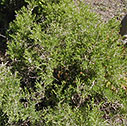
Wild Rose- Wild rose is a large shrub with small
thorns and pale-green oval leaves. Blossoms are pink with a yellow center.
Western Juniper ( Juniperus Occidentalis)- A small
rounded coniferous tree that is usually around 30 ft tall. The bark is
thin and stringy and has a grayish brown color. It has scale like leaves
that are a green-gray and it produces cones, which when ovulate look like
blue berries.
Cattail- ( Typha latifolia)- A 1-3 meter tall marsh or semiaquatic perennials that lives near slow moving water in marshes, ponds, lakeshores. The leaves are grayish green and long, flat and narrow with a width of 1-2 cm and sheath at the base. The flowers are numerous and are in the shape of a cylindrical spike. They are 15-20 cm long with the bottom half being dark brown and the female section, where the top half is the male section with a lighter dried up look that eventually leaves the tip bare.
Wild Onion- (Allumium stellatum): The wild onion is in the lily family. It has 6-point pinkish-purple umbrella like flowers, grass like leaves, and a bulb with a pongent onion like smell.

Lupine- (Lupinus perennis): The Lupines have
a blue-violet colored bloom and radiating segmented leaves. The blooms
grow along a tall upright center stem that stands 6 to 10 inches tall.
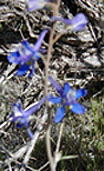
Bitter Root- (Lewisia rediviva): Bitterroot is a low growing herb, with small leaves and large light pink blooms. The root is edible.
Death Camas- (Xerophyllum tenax): The Death Camas has grass like leaves and usually bears a cluster of flowers on a tall upright stalk.
Balsam Root- (Impatiens balsamina): The Balsamroot is an annual herb that stands about 1 to2 feet tall. It has finely toothed leaves and a yellow sunflower-like bloom.
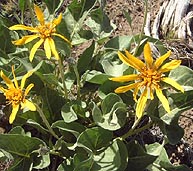
Buck Wheat- (Polygonaceae): The Buckwheat we found
was one of 800 species. It was a small cluster of pinkish flowers atop
a thin stem.
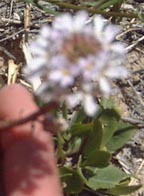
And 1 Panda Bear
Common Mullein -(Verbascum thapsus): The Mullein has large, hairy, broad leaves from which it grows a central stock that can be from 2 to7 feet tall. The top of the stock is covered with yellow knobby-like blooms.
Willow- (Salicaceae): The Willow is a fast growing tree with simple narrow leaves. There are 300 different kinds of Willow. The ones most commonly seen in this area where found next to the streams and lakes.
Sagebrush -(ArtemisiaTridentata): Sagebrush has many dry branches and grey or green in color. Widespread and common at low to mid-level elevations in arid grasslands.
Rabbitbrush- (Chrysothamnus nauseosus): This bush grows to about three feet tall and have dense grayish, velvety hairs on the leaves. Widespread and common at low to mid-level elevations in grasslands, dry, open Douglas-fir forests, and disturbed areas.
Hopsage- (Atriplex spinosa): This sage is medium sized with small flowers and resembles typical sagebrush. Grows in a wide variety of habitats ranging from talus slopes to alkaline flats.
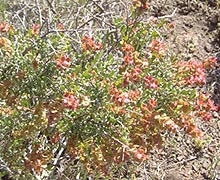
Hawksbeard- (Crepis species): Grows up to two feet tall with yellow flowers that don’t show themselves until early summer. Green in color with sharp leaves.
Indian Paintbrush- (Castilleja species): This plant
is parasitic and feds off the roots of sagebrush and grows low to the ground.
Has red, orange, or even yellow flowers that attract hummingbirds and some
insects. Is a perennial plant with woody, well-branched root system.
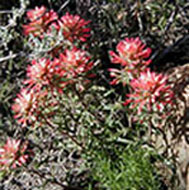
Locoweed - ( A. purshii) : A tall, many stemmned plant with elongate clusters of white or violet flowers. Very common in sagebrush
Teasel- (Dipsacus) A wide spread
weed, with long leaves, that are toothed and prickly on the edges. The
stem can get to a height of 5 feet or more and branches near the top to
form cone shaped clusters of lavender or blue flowers among stiff bristles.